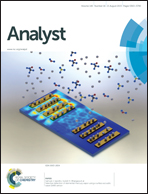Differential toxicity of gold-doxorubicin in cancer cells vs. cardiomyocytes as measured by real-time growth assays and fluorescence lifetime imaging microscopy (FLIM)†
Abstract
The kinetics of toxicity of doxorubicin (Dox) and gold nanoparticle-conjugated doxorubicin (Au-Dox) were investigated in cultured B16 melanoma cells and cardiomyocytes using real-time cell-growth imaging. Both bolus exposure and continuous exposure were used. Modeling of the growth curve dynamics suggested patterns of uptake and/or expulsion of the drug that were different for the different cell lines and exposures. Dox alone in B16 cells fit to a model of slow drug buildup, whereas Au-Dox fit to a pattern of initial high drug efficacy followed by a decrease. In cardiomyocytes, the best fit was to a model of increasing drug concentration which then began to decrease, consistent with breakdown of the doxorubicin in solution. Cardiomyocytes were more sensitive than B16 cells to Dox alone (IC50 123 ± 2 nM vs. 270 ± 2 nM with continuous exposure), but were dramatically less sensitive to Au-Dox (IC50 1 ± 0.1 μM vs. 58 ± 5 nM with continuous exposure). Bolus exposure for 40 min led to significant cell death in B16 cells but not in cardiomyocytes. Fluorescence lifetime imaging (FLIM) showed different patterns of uptake of Au-Dox in the two cell types that explained the differential toxicity. While Au-Dox concentrated in the nuclei of B16 cells, it remained endosomal in cardiomyocytes. These results suggest that stable conjugates of nanoparticles to doxorubicin may be useful for treating resistant cancers while sparing healthy tissue.


 Please wait while we load your content...
Please wait while we load your content...